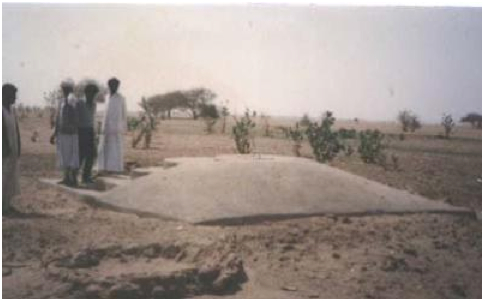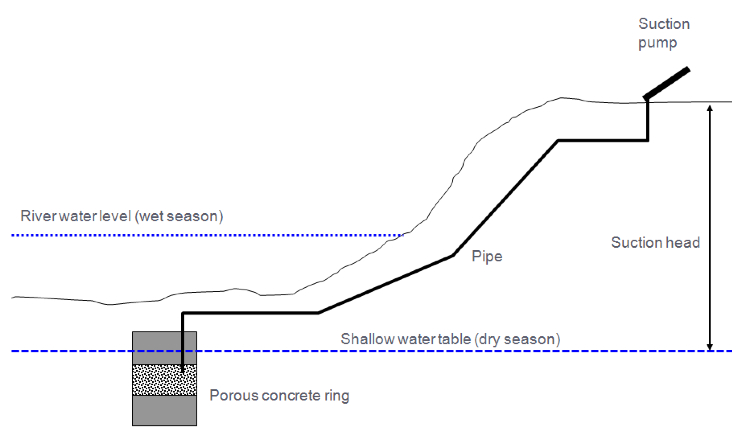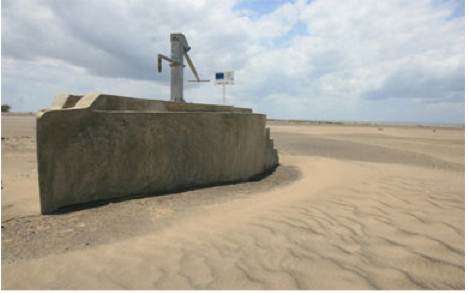Difference between revisions of "河床人工井"
Weichen Chen (talk | contribs) (→干旱) |
Weichen Chen (talk | contribs) (→Construction, operations and maintenance) |
||
| Line 38: | Line 38: | ||
更多关于治理干旱的信息,请查看: [[Resilient WASH systems in drought-prone areas|易干旱地区具有适应性的 WASH 系统]]。 | 更多关于治理干旱的信息,请查看: [[Resilient WASH systems in drought-prone areas|易干旱地区具有适应性的 WASH 系统]]。 | ||
| − | === | + | ===修建、运作和维护=== |
| − | [[Image:RiverbedWellWithHandpump.jpg|thumb|right|200px| | + | [[Image:RiverbedWellWithHandpump.jpg|thumb|right|200px| 配有手泵的河床井. Eric Fewster, BushProof. <br> (点击图片放大)]] |
| − | [[Image:NewRiverbedWell.jpg|thumb|right|200px| | + | [[Image:NewRiverbedWell.jpg|thumb|right|200px| 新河床井。新水井的水动力设计说明即使在雨季,水井也不会被流速快的河流冲刷走或毁坏。水井中的水比没有受到保护的洞中的水更加干净,并且取水方式更加安全。这种方式比传统的方式更节约时间,因为不用每到旱季就重新挖一次. 图片来源: Jane Beesley.]] |
| − | ''' | + | '''关于水泥的建议''': 建筑和隔板(例如水箱、大坝、水道和水井)出现裂缝的常见原因是在混合和使用水泥时出错。首先,很重要的一点是使用的成分一定要纯:干净的水、沙子和岩石,这些成分必须充分混合。第二,混合时使用的水尽量少:混凝土或水泥成形即可,宁可干点,也不要成为液体。第三,在固化过程中混凝土或水泥需要保持一定的水分,至少维持一周。同时,在固化过程中应该用塑料、大树叶或其他材料覆盖在引水建筑物上以保持水分。 |
| − | ''' | + | '''具体建议''': |
| − | + | 修建方式更为简单安全,质量更加坚固。可使用预制的混凝土环,但使用切割底垫圈和弯道砖会更加容易,有些由透水混凝土制成。 | |
| − | + | 请确保水井足够深,才能在旱季也有足够的水量。 | |
| − | + | 对于有大量泥土的沙河而言,渗透性很差,储水量也不多。在井身周围制作大量的砾石过滤层可加快水流入水井的速度。砾石过滤层由集料和石头组成(与井眼中使用的传统小型砾石过滤层不同)。 | |
| − | + | 对于完全在河床(会遭遇洪水或邻近洪水)中或者部分在河床中的水井而言: | |
| − | * | + | * 可制作井身,因此井身会掩埋在沙子下面,并在每次洪水之后暴露出来,由此获取水。可使用厚板覆盖混凝土环顶端,并在旱季使用检查井的检修盖,在雨季将其关闭。在这样的情况下: |
| − | ** | + | **混凝土环的顶部最好离河床1.5米,因此: |
| − | # | + | # 雨季发生洪水时,表面至少仍有少量的水渗入。 |
| − | # | + | # 在洪水来临的时候,井身和管道被冲刷走的几率降低。不同河流中的沙子深度不同,但记录显示在季节性河流中通常在0.66至2米之间。 |
| − | * | + | * 也可以修建井身使其高于河床沙子。可使用厚板覆盖混凝土环的顶部,并在旱季使用检查井的检修盖。在这样的情况下: |
| − | ** | + | ** 需要保护井身,应该修建水动力的井口装置,以便减小洪水及其碎片的破坏力。井口装置形状如同倒扣的船,这样可以引开洪水和碎片。检查井的井盖在逆流方向将打开,因此在洪水来临时会闭合。 |
| − | ** | + | ** 这可能最适合少孔和渗透性差的河床,沉淀物不会被洪水冲走,否则水井很容易遭到破坏。 |
| − | + | 在井身水下部分使用透水混凝土可以帮助加快流入水井的水流速度。透水混凝土由混凝土、泥沙和集料按照1:1:4的比例制成,并可用作弯道砖或任何预制混凝土环的中间部分。并且可使用千斤顶将多孔尖头钢管水平插入含水层,这也可以加快水流入水井的速度。 | |
===Manuals, videos and links=== | ===Manuals, videos and links=== | ||
Revision as of 08:47, 15 November 2015
这些浅井从河床中天然或人工含水层中抽取水。最简单的就是每到旱季在河床中挖一个浅层洞,每次发洪水时河床就会被淹。使用其他方式时,可通过手泵 或小型高效电动泵在全年都能获取水资源。可使用水桶和绳子,但是会增加污染的风险。因此,应该提倡使用家用水处理。
适宜条件
- 水井应该建在一年中有一段时间干旱的河床上,这样才能进行施工。
- 即使在旱季,河床中也应该有水。
- 如果挖取水井目的是使用手动或电动方式抽取水,根据水泵要求最好将水井建在:
- 水泵30米范围内。
- 在河堤较矮及洪水最高高度也不及河堤的地方。因此仍可以使用真空泵,并能有效抽取6-7米高的水。
| 优势 | 劣势 |
|---|---|
| - 从河床而不是通过河堤取水(承压含水层中水在河床) - 由于需要的衬砌数量减少,因此比在河床修建衬砌井费用更低 |
- 由于地表水与取水口之间的渗透深度有限,可能导致水受到污染 - 可能很难下沉到理想的深度,尤其是在流沙地区 |
应对环境变化的适应性
干旱
干旱的后果: 可能干涸
潜在的原因: 由于降雨减少,含水层的补给也变少;人口增加,用水需求也增加;含水层的面积——例如沙量有限;水井在地下水位中不够深;位置不当;管道周围的级配砾石分布不当。
增加 WASH 系统的适应性: 通过修建地下水坝增加水量;将水井和管道放置在更深的地方;在水位范围内沉箱时使用排水井;在旱季后半段修建;在一年中部分时间干旱的河床中修建,并且河床在旱季时也有水;通过将透水混凝土和多孔尖头钢管水平插入含水层(河床水井)和级配砾石(渗水渠和射流井)中增加流量;在没有沉积(渗水渠)的退化河中修建;在管道周围铺设级配砾石,减少淤积并增加流量。
更多关于治理干旱的信息,请查看: 易干旱地区具有适应性的 WASH 系统。
修建、运作和维护
关于水泥的建议: 建筑和隔板(例如水箱、大坝、水道和水井)出现裂缝的常见原因是在混合和使用水泥时出错。首先,很重要的一点是使用的成分一定要纯:干净的水、沙子和岩石,这些成分必须充分混合。第二,混合时使用的水尽量少:混凝土或水泥成形即可,宁可干点,也不要成为液体。第三,在固化过程中混凝土或水泥需要保持一定的水分,至少维持一周。同时,在固化过程中应该用塑料、大树叶或其他材料覆盖在引水建筑物上以保持水分。
具体建议: 修建方式更为简单安全,质量更加坚固。可使用预制的混凝土环,但使用切割底垫圈和弯道砖会更加容易,有些由透水混凝土制成。
请确保水井足够深,才能在旱季也有足够的水量。
对于有大量泥土的沙河而言,渗透性很差,储水量也不多。在井身周围制作大量的砾石过滤层可加快水流入水井的速度。砾石过滤层由集料和石头组成(与井眼中使用的传统小型砾石过滤层不同)。
对于完全在河床(会遭遇洪水或邻近洪水)中或者部分在河床中的水井而言:
- 可制作井身,因此井身会掩埋在沙子下面,并在每次洪水之后暴露出来,由此获取水。可使用厚板覆盖混凝土环顶端,并在旱季使用检查井的检修盖,在雨季将其关闭。在这样的情况下:
- 混凝土环的顶部最好离河床1.5米,因此:
- 雨季发生洪水时,表面至少仍有少量的水渗入。
- 在洪水来临的时候,井身和管道被冲刷走的几率降低。不同河流中的沙子深度不同,但记录显示在季节性河流中通常在0.66至2米之间。
- 也可以修建井身使其高于河床沙子。可使用厚板覆盖混凝土环的顶部,并在旱季使用检查井的检修盖。在这样的情况下:
- 需要保护井身,应该修建水动力的井口装置,以便减小洪水及其碎片的破坏力。井口装置形状如同倒扣的船,这样可以引开洪水和碎片。检查井的井盖在逆流方向将打开,因此在洪水来临时会闭合。
- 这可能最适合少孔和渗透性差的河床,沉淀物不会被洪水冲走,否则水井很容易遭到破坏。
在井身水下部分使用透水混凝土可以帮助加快流入水井的水流速度。透水混凝土由混凝土、泥沙和集料按照1:1:4的比例制成,并可用作弯道砖或任何预制混凝土环的中间部分。并且可使用千斤顶将多孔尖头钢管水平插入含水层,这也可以加快水流入水井的速度。
Manuals, videos and links
- Well revival effort sees many other benefits A community drive to revive wells in Mokhla talab near Udaipur results in water security for longer periods of time as well as making leaders out of women.
- Experiments with 'community wells' Mobilized farmers in Dhule, Maharashtra, show how communities can use groundwater as a common resource in an organised and collective manner.
- Water from dry riverbeds. Advises how to survey a river and much more. Danish International Development Assistance (Danida). 2006.
- Hand-dug well equipment. Covering well auger survey, well digging, dewatering and desludging kits. Oxfam Water Supply Scheme for Emergencies.
Acknowledgements
- CARE Nederland, Desk Study: Resilient WASH systems in drought-prone areas October 2010.




